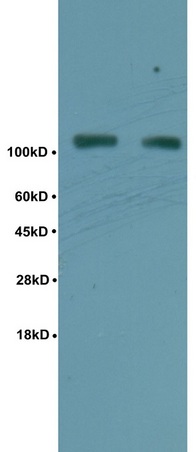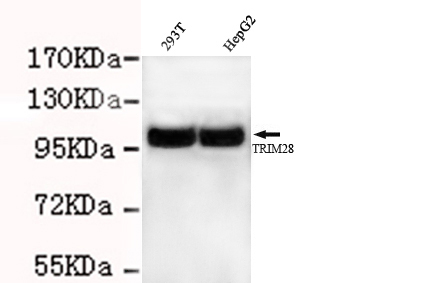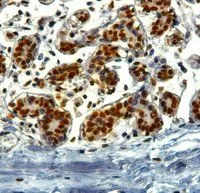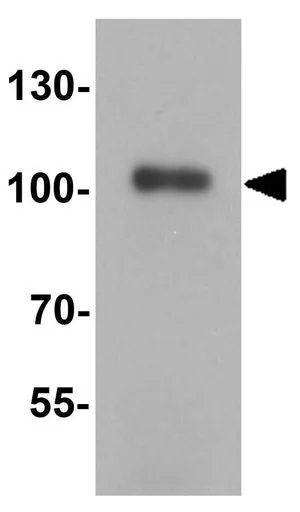KAP1 antibody [N3C2], Internal
GTX102226
ApplicationsImmunoFluorescence, ImmunoPrecipitation, Western Blot, ChIP Chromatin ImmunoPrecipitation, ImmunoCytoChemistry, ImmunoHistoChemistry, ImmunoHistoChemistry Paraffin
Product group Antibodies
TargetTRIM28
Overview
- SupplierGeneTex
- Product NameKAP1 antibody [N3C2], Internal
- Delivery Days Customer9
- Application Supplier NoteWB: 1:1000-1:10000. ICC/IF: 1:100-1:1000. IHC-P: 1:100-1:1000. IP: 1:500-1:1000. *Optimal dilutions/concentrations should be determined by the researcher.Not tested in other applications.
- ApplicationsImmunoFluorescence, ImmunoPrecipitation, Western Blot, ChIP Chromatin ImmunoPrecipitation, ImmunoCytoChemistry, ImmunoHistoChemistry, ImmunoHistoChemistry Paraffin
- CertificationResearch Use Only
- ClonalityPolyclonal
- Concentration0.48 mg/ml
- ConjugateUnconjugated
- Gene ID10155
- Target nameTRIM28
- Target descriptiontripartite motif containing 28
- Target synonymsKAP1, PPP1R157, RNF96, TF1B, TIF1B, TIF1beta, WT7, transcription intermediary factor 1-beta, E3 SUMO-protein ligase TRIM28, KAP-1, KRAB [Kruppel-associated box domain]-associated protein 1, KRAB-interacting protein 1, KRIP-1, RING finger protein 96, RING-type E3 ubiquitin transferase TIF1-beta, TIF1-beta, nuclear corepressor KAP-1, protein phosphatase 1, regulatory subunit 157, transcriptional intermediary factor 1-beta
- HostRabbit
- IsotypeIgG
- Protein IDQ13263
- Protein NameTranscription intermediary factor 1-beta
- Scientific DescriptionThe protein encoded by this gene mediates transcriptional control by interaction with the Kruppel-associated box repression domain found in many transcription factors. The protein localizes to the nucleus and is thought to associate with specific chromatin regions. The protein is a member of the tripartite motif family. This tripartite motif includes three zinc-binding domains, a RING, a B-box type 1 and a B-box type 2, and a coiled-coil region. [provided by RefSeq]
- Storage Instruction-20°C or -80°C,2°C to 8°C
- UNSPSC12352203
References
- Fowler FC, Chen BR, Zolnerowich N, et al. DNA-PK promotes DNA end resection at DNA double strand breaks in G(0) cells. Elife. 2022,11. doi: 10.7554/eLife.74700Read this paper
- Chen BR, Wang Y, Shen ZJ, et al. The RNF8 and RNF168 Ubiquitin Ligases Regulate Pro- and Anti-Resection Activities at Broken DNA Ends During Non-Homologous End Joining. DNA Repair (Amst). 2021,108:103217. doi: 10.1016/j.dnarep.2021.103217Read this paper
- Chen BR, Wang Y, Tubbs A, et al. LIN37-DREAM prevents DNA end resection and homologous recombination at DNA double-strand breaks in quiescent cells. Elife. 2021,10. doi: 10.7554/eLife.68466Read this paper
- Liu B, Li X, Liu F, et al. Expression and Significance of TRIM 28 in Squamous Carcinoma of Esophagus. Pathol Oncol Res. 2019,25(4):1645-1652. doi: 10.1007/s12253-018-0558-6Read this paper
- Hsieh YH, Deng JS, Chang YS, et al. Ginsenoside Rh2 Ameliorates Lipopolysaccharide-Induced Acute Lung Injury by Regulating the TLR4/PI3K/Akt/mTOR, Raf-1/MEK/ERK, and Keap1/Nrf2/HO-1 Signaling Pathways in Mice. Nutrients. 2018,10(9). doi: 10.3390/nu10091208Read this paper
- Hung PJ, Johnson B, Chen BR, et al. MRI Is a DNA Damage Response Adaptor during Classical Non-homologous End Joining. Mol Cell. 2018,71(2):332-342.e8. doi: 10.1016/j.molcel.2018.06.018Read this paper
- Huang TH, Shen ZJ, Sleckman BP, et al. The histone chaperone ASF1 regulates the activation of ATM and DNA-PKcs in response to DNA double-strand breaks. Cell Cycle. 2018,17(12):1413-1424. doi: 10.1080/15384101.2018.1486165Read this paper
- Wang L, Wolgemuth DJ. BET Protein BRDT Complexes With HDAC1, PRMT5, and TRIM28 and Functions in Transcriptional Repression During Spermatogenesis. J Cell Biochem. 2016,117(6):1429-38. doi: 10.1002/jcb.25433Read this paper
- Tubbs AT, Dorsett Y, Chan E, et al. KAP-1 promotes resection of broken DNA ends not protected by γ-H2AX and 53BP1 in G₁-phase lymphocytes. Mol Cell Biol. 2014,34(15):2811-21. doi: 10.1128/MCB.00441-14Read this paper
- Aslanian A, Yates JR 3rd, Hunter T. Mass spectrometry-based quantification of the cellular response to methyl methanesulfonate treatment in human cells. DNA Repair (Amst). 2014,15:29-38. doi: 10.1016/j.dnarep.2013.12.007Read this paper






![WB analysis of nuclear enriched extracts (30 microg lysate) of HEK 293 treated with Hydrogen peroxide (100um Hydrogen peroxide for 10 min) (Lane 1), HEK 293 (Lane 2), A549 (Lane 3), HEL 92.1.7 (Lane 4), PC-3 (Lane 5), and Caco-2 (Lane 6) using GTX80695 KAP1 antibody [20C1]. Dilution : 1 microg/ml](https://www.genetex.com/upload/website/prouct_img/normal/GTX80695/GTX80695_1954_WB_w_23061322_422.webp)

